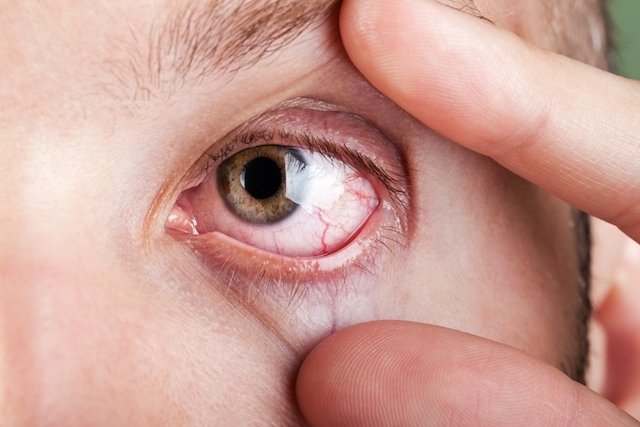Dry, red, swollen eyes and a feeling of grit in the eyes are common symptoms of conditions such as conjunctivitis or uveitis. However, these signs and symptoms may also indicate another type of disease that affects the joints and blood vessels, rheumatic diseases, such as lupus, Sjogren’s syndrome and rheumatoid arthritis, at any stage of life.
Generally, rheumatic diseases are discovered through specific exams, but the ophthalmologist may suspect that the person has this type of disease through an eye fundus exam, an exam that shows exactly the state of the optic nerve, the veins and arteries that irrigate the eyes, indicating the health of these structures. And if these small blood vessels are compromised, it is possible that others are too and therefore the ophthalmologist may recommend that the person see a rheumatologist.

7 Rheumatological diseases that can affect the eyes
Some rheumatological diseases that may have ocular manifestations are:
1 – Rheumatoid, psoriatic and juvenile arthritis
Arthritis, which is joint inflammation that can have different causes that are not always fully understood, can also affect the eyes, causing changes such as conjunctivitis, scleritis and uveitis. In addition to the disease itself being able to have ocular implications, medications such as hydroxychloroquine and chloroquine can have side effects that appear in the eyes, which is why it is necessary for a person with arthritis to have a fundus examination every six months. Learn how to identify rheumatoid arthritis.
2 – Lupus erythematosus
People with lupus are at greater risk of dry eye syndrome, which manifests itself through symptoms such as burning and pain in the eyes, flushing, a feeling of sand in the eyes and dry eyes. In addition to the disease itself being able to affect the eyes, the corticosteroid medications used to treat Lupus can also have side effects on the eyes and can cause dry eye syndrome, cataracts and glaucoma.
3 – Sjogren’s syndrome
It is a disease where the body itself attacks the cells that produce saliva and tears, leaving the mouth and eyes very dry. Dry eye syndrome is common, which increases the risk of chronic conjunctivitis.. The person’s eyes are always dry, red, sensitive to light and the feeling of sand in the eyes can be frequent.
4 – Ankylosing spondylitis
This is a disease where there is inflammation in tissues, including in the eyes, causing uveitis, usually in just 1 eye. The eye may become red and swollen and if the disease persists for months, the other eye may also be affected, with a greater risk of corneal complications and cataracts.
5 – Behçet’s syndrome
It is a very rare disease in Brazil, characterized by inflammation in the blood vessels, which is generally diagnosed in adolescence, but which can seriously affect the eyes, causing uveitis with pus in both eyes and inflammation in the optic nerve. Treatment can be done with immunosuppressants such as azathioprine, cyclosporine A and cyclophosphamide to control symptoms.
6 – Polymyalgia rheumatica
It is a disease characterized by pain in the shoulders, back and difficulty moving due to stiffness in the hip and shoulder joint, with complaints of pain throughout the body being common. When the ocular arteries are involved, blurred vision, double vision and even blindness can occur, which can affect only one or both eyes.
7 – Reiter’s syndrome
It is a type of arthritis that causes pain and inflammation in the joints but can also cause inflammation in the whites of the eyes and eyelids, leading to conjunctivitis or uveitis, for example.
Although it is more common for people to discover rheumatic disease first, it is possible that eye involvement may indicate the presence of rheumatic diseases. But to reach this diagnosis it is necessary to carry out a series of tests such as joint x-rays, MRI and a genetic test to identify rheumatoid factor, for example.
How to treat eye complications caused by rheumatism
Treatment for eye diseases that are directly related to rheumatological diseases must be guided by an ophthalmologist and rheumatologist and may include the use of medicines, eye drops and ointments to apply to the eyes.
When these diseases occur due to the side effects of medications, the doctor may recommend that they be changed to another to improve the quality of the person’s vision, but sometimes it is enough to treat the rheumatological disease for the ocular symptoms to improve.

Sign up for our newsletter and stay up to date with exclusive news
that can transform your routine!
Warning: Undefined array key "title" in /home/storelat/public_html/wp-content/plugins/link-whisper-premium/templates/frontend/related-posts.php on line 12
Warning: Undefined array key "title_tag" in /home/storelat/public_html/wp-content/plugins/link-whisper-premium/templates/frontend/related-posts.php on line 13



